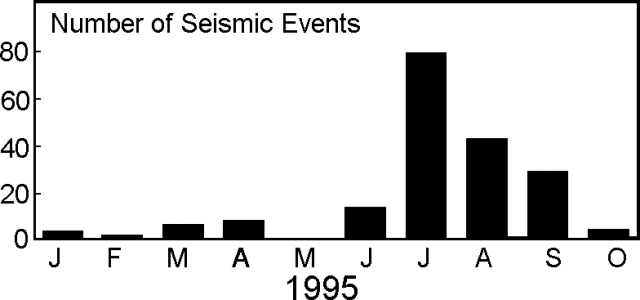Report on Rincon de la Vieja (Costa Rica) — October 1995
Bulletin of the Global Volcanism Network, vol. 20, no. 10 (October 1995)
Managing Editor: Richard Wunderman.
Rincon de la Vieja (Costa Rica) New eruption; lahars damage a bridge and lead to evacuations
Please cite this report as:
Global Volcanism Program, 1995. Report on Rincon de la Vieja (Costa Rica) (Wunderman, R., ed.). Bulletin of the Global Volcanism Network, 20:10. Smithsonian Institution. https://doi.org/10.5479/si.GVP.BGVN199510-345020
Rincon de la Vieja
Costa Rica
10.83°N, 85.324°W; summit elev. 1916 m
All times are local (unless otherwise noted)
A new phreatomagmatic eruption followed three months of declining seismicity. During 1995 the number of local earthquakes peaked in July and then progressively decreased (figure 10). Prior to the eruption, during October, OVSICORI-UNA reported that park rangers who ascended to the main summit saw increased degassing and noted the appearance of fumaroles along cracks at the E and NE crater margins. Rangers described the crater lake's color as green and the smell as strong and sulfurous.
ICE described the eruption as phreatomagmatic, beginning at 1504 on 6 November, and climaxing on 8 November with 25 explosions. They noted the ash-bearing and steam-rich columns rose to 1 and 4 km, respectively, above the crater. Ash blew WSW; medium- to fine-grained ash reached up to 30 km from the volcano (Santa Rosa National Park).
According to ICE, on 9 November the eruption entered a steam-rich phase. Columns typically rose 200 m, but sometimes as much as 1.5 km after some steam explosions.
During the course of the eruption, ballistic ejecta were thrown over a zone extending to ~1 km N. Ejecta formed lahars that followed two key rivers (Penjamo and Azul rivers) and their tributaries. Heavy rains beginning on 10 and continuing on 11 November triggered secondary lahars and associated floods; a bridge 7 km N of the crater (Penjamo bridge) was damaged but not destroyed, interrupting traffic flow. During this episode, lahars along a tributary of the Penjamo river produced a gully 8-m deep and 25-m wide, isolating some inhabitants.
Initial inspections of ash and the lahar matrix indicated that they mainly consisted of hydrothermally altered fragments, lake-sediment mud, and vesiculated glassy andesite fragments.
Some residents living near the volcano were evacuated to a safe village 9 km NW of the crater. News reports on 8 November by both Associated Press and Deutsche Presse-Agentur stated that about 100 families were evacuated. Two days later Enrique Coen reported relocation of 300 families.
Geological Summary. Rincón de la Vieja, the largest volcano in NW Costa Rica, is a remote volcanic complex in the Guanacaste Range. The volcano consists of an elongated, arcuate NW-SE-trending ridge constructed within the 15-km-wide early Pleistocene Guachipelín caldera, whose rim is exposed on the south side. Sometimes known as the "Colossus of Guanacaste," it has an estimated volume of 130 km3 and contains at least nine major eruptive centers. Activity has migrated to the SE, where the youngest-looking craters are located. The twin cone of Santa María volcano, the highest peak of the complex, is located at the eastern end of a smaller, 5-km-wide caldera and has a 500-m-wide crater. A Plinian eruption producing the 0.25 km3 Río Blanca tephra about 3,500 years ago was the last major magmatic eruption. All subsequent eruptions, including numerous historical eruptions possibly dating back to the 16th century, have been from the prominent active crater containing a 500-m-wide acid lake located ENE of Von Seebach crater.
Information Contacts: E. Fernandez, E. Duarte, and V. Barboza, Observatorio Vulcanológico y Sismológico de Costa Rica, Universidad Nacional (OVSICORI-UNA), Apartado 86-3000, Heredia, Costa Rica; G.J. Soto, Oficina de Sismologia y Vulcanologia del Arenal y Miravalles: OSIVAM, Instituto Costarricense de Electricidad (ICE), Apartado 10032-1000, San José, Costa Rica; Enrique Coen, Departamento de Fisica, University Nacional, Heredia, Costa Rica; Associated Press; Deutsche Presse-Agentur.


